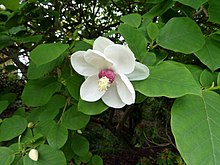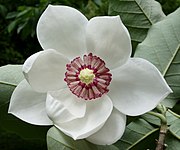bio.wikisort.org - Plant
Magnolia sieboldii, or Siebold's magnolia, also known as Korean mountain magnolia[2] and Oyama magnolia,[3] is a species of Magnolia native to east Asia in China, Japan, and Korea. It is named after the German doctor Philipp Franz von Siebold (1796–1866).
| Siebold's magnolia | |
|---|---|
 | |
| Scientific classification | |
| Kingdom: | Plantae |
| Clade: | Tracheophytes |
| Clade: | Angiosperms |
| Clade: | Magnoliids |
| Order: | Magnoliales |
| Family: | Magnoliaceae |
| Genus: | Magnolia |
| Subgenus: | Magnolia subg. Magnolia |
| Section: | Magnolia sect. Rhytidospermum |
| Subsection: | Magnolia subsect. Oyama |
| Species: | M. sieboldii |
| Binomial name | |
| Magnolia sieboldii | |
| Synonyms[1] | |
| |
Description
Magnolia sieboldii is a large deciduous shrub or small tree 5–10 m (16–33 ft) tall. The stalks, young leaves, young twigs and young buds are downy. The leaves are elliptical to ovate-oblong, 9–16 cm (rarely 25 cm) long and 4–10 cm (rarely 12 cm) broad, with a 1.5-4.5 cm petiole.
The flowers, unlike the spring flowering magnolias, open primarily in the early summer, but continue intermittently until late summer. They are pendulous, cup-shaped, 7–10 cm diameter, and have 6-12 tepals, the outer three smaller, the rest larger, and pure white; the carpels are greenish and the stamens reddish-purple or greenish-white.
Subspecies
There are three subspecies:
- Magnolia sieboldii subsp. japonica. Japan. Low shrub; flowers with 6 tepals and greenish-white stamens.
- Magnolia sieboldii subsp. sieboldii. Japan, Korea, eastern China. Tree or large shrub; flowers with 9-12 tepals and reddish-purple stamens; leaves smaller, rarely over 16 cm.
- Magnolia sieboldii subsp. sinensis. Southwestern China (Sichuan); flowers as subsp. sieboldii; leaves larger, commonly to 22 cm.
- Flower bud
- Flower, male phase
- Flower
- Flower detail
- Immature fruit
- Nearly mature fruit
Cultivation
Magnolia sieboldii is grown as an ornamental tree in gardens. It is one of the hardiest magnolias, successful in cultivation as far north as Arboretum Mustila in Finland. The cultivar 'Colossus' has gained the Royal Horticultural Society's Award of Garden Merit.[4]
Called mongnan or mokran (목란/木蘭), Siebold's magnolia is the national flower of North Korea.[5]
References
- The Plant List: A Working List of All Plant Species, retrieved 28 January 2017
- English Names for Korean Native Plants (PDF). Pocheon: Korea National Arboretum. 2015. p. 532. ISBN 978-89-97450-98-5. Archived from the original (PDF) on 25 May 2017. Retrieved 24 December 2016 – via Korea Forest Service.
- "Magnolia sieboldii (Oyama Magnolia) | North Carolina Extension Gardener Plant Toolbox". plants.ces.ncsu.edu. Retrieved 2022-03-25.
- "Magnolia sieboldii 'Colossus' AGM". Royal Horticultural Society. 2017. Retrieved 2017-01-27.
- Lim, Reuben C. J. (29 June 2013). "Floral Emblems of the world". anbg.gov.au. Australian National Herbarium. Retrieved 9 September 2016.
- Hunt, D. (ed). (1998). Magnolias and their allies. International Dendrology Society and Magnolia Society. ISBN 0-9517234-8-0
- Flora of China: Magnoliaceae (draft account)
External links
- Hong, Kyong-sik (1992). Magnolia Sieboldii: Korea's National Flower (PDF). Pyongyang: Foreign Languages Publishing House. OCLC 52473426.
- Friedman, William (Ned). "Oyama magnolia in full bloom." Posts from the Collections, Arnold Arboretum of Harvard University website, June 12, 2016. Accessed 1 October 2019.
- Magnolia sieboldii images at the Arnold Arboretum of Harvard University Plant Image Database.
На других языках
- [en] Magnolia sieboldii
[es] Magnolia sieboldii
La magnolia de Siebold (Magnolia sieboldii), también conocida como magnolia Oyama, es una especie de Magnolia nativa del este de Asia en China, Japón, y Corea.[ru] Магнолия Зибольда
Магнолия Зибольда (лат. Magnolia sieboldii) — вид цветковых растений, входящий в род Магнолия семейства Магнолиевые, произрастающий в Восточной Азии: в Китае, Японии и Корее. Выращивается в садах как декоративное растение. Относится к наиболее зимостойким представительницам своего рода[2]. Является национальным цветком Северной Кореи[3]. Цветение происходит в мае-июне, а плодоношение — в сентябре-октябре. Размножается черенками, семенами и отводками.Другой контент может иметь иную лицензию. Перед использованием материалов сайта WikiSort.org внимательно изучите правила лицензирования конкретных элементов наполнения сайта.
WikiSort.org - проект по пересортировке и дополнению контента Википедии





